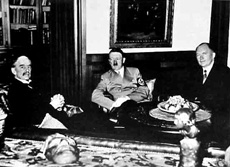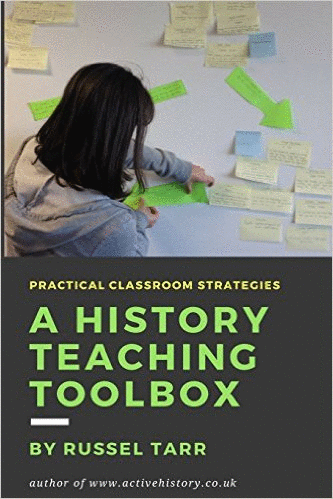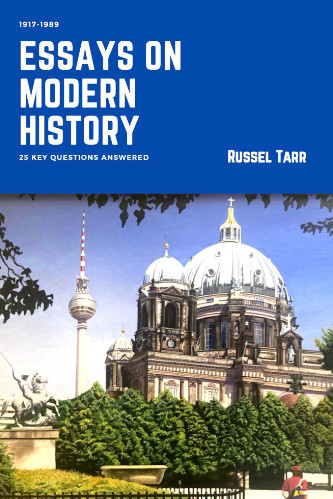World History teaching resources for the high school classroom: lesson plans, worksheets, quizzes and simulation games for KS3, IGCSE, IB and A-Level teachers.
Coursework Assignment: "To what extent did the policy of appeasement cause the Second World War?"
“How horrible, fantastic, incredible it is that we should be digging trenches and trying on gas-masks here because of a quarrel in a far-away country between people of whom we know nothing!” – Neville Chamberlain, 1938Introduction
 "Appeasement" can be defined as "giving in to someone's demands as far as is reasonably possible to avoid conflict". Throughout the 1930s, Britain and France in particular were very keen on using this policy. They used it in their dealings with Japan (who attacked Manchuria), Italy (who attacked Abyssinnia) and of course Germany (who reached a Naval Agreement with Britain, remilitarised the Rhineland, secured an Anshcluss with Austria and took control of the Sudetenland).
"Appeasement" can be defined as "giving in to someone's demands as far as is reasonably possible to avoid conflict". Throughout the 1930s, Britain and France in particular were very keen on using this policy. They used it in their dealings with Japan (who attacked Manchuria), Italy (who attacked Abyssinnia) and of course Germany (who reached a Naval Agreement with Britain, remilitarised the Rhineland, secured an Anshcluss with Austria and took control of the Sudetenland).
Since World War Two, politicians have been desperate to avoid being accused of appeasement. This has created aggressive foreign policies which are arguably much less well-considered, and just as damaging: Britain plunged into the Suez Crisis and the USA got bogged down in Vietnam (and now Iraq) rather than "surrender" to the demands of "the next Hitler".
This essay assignment will test your ability to
- Explain how and why Britain and France pursued a policy of appeasement
- Explain how appeasement led to World War Two
- Explain how other factors also contributed
- Explain how these factors are linked together to reach a conclusion.
Although class time will be given over to this assignment, you will also be expected to work on it at home. Your teacher will be able to give you some general advice on structuring essays and about events, issues and concepts - but the actual assignment must be entirely your own work.
Stage 1: Gather your evidence, form your views
Through your studies, you should already be familiar with the main causes of World War Two (German bitterness about Versailles; weaknesses of the League of Nations; the impact of the Depression; the rise of aggressive dictatorships in Japan, Italy and Germany; the policy of appeasement led by Britain and France).
- Video: Start by watching the classic "Why Appeasement" video (ask your teacher for this) and completing this accompanying worksheet. You should also make a special note of all the ways in which appeasement was defended at the time as being a good idea.
- Structured investigation : Then, do the ActiveHistory structured investigation. This will help you to decide which factors to look at, and how to link them. You can also consider the question "What were the main reasons for appeasement?" using this Diamond 9 diagram based at www.classtools.net.
- Google Earth Tour: Causes of World War Two, 1919-39: An animated flyover. Complete with a worksheet, this will not only teach you about the main events, but encourage you to reflect on the shifting pattern of international alliances. [note: needs Google Earth to be installed!]
- Quizzes: Some games and quizzes designed to test your factual knowledge can be found on this page of ActiveHistory.
- Audio: Chamberlain explains his position in a British radio broadcast shortly before flying to Munich.
Stage 2: Write the first draft of your essay
Once you feel confident that you understand the events and issues, you can start thinking about writing your essay.
Exhibit A. A sample markscheme for an essay at GCSE / IGCSE level.
L1 |
General points; little evidence of background knowledge from classroom studies |
L2 |
One-sided answer; factual details about one factor described |
L3 |
One-sided answer; role of one factor explained OR Multi-causal answer; factual details about several factors described |
L4 |
Multi-causal answer; role of several factors explained, but in isolation |
L5 |
Multi-causal answer; role of several factors explained, and linked together |
Exhibit B. How to write essays at GCSE / IGCSE History. A step-by-step guide by Mr. Tarr.
Stage 3: Write the final draft of your essay
In theory, your essay could be handed in at this point. However, before doing so it is a good idea to have a look at some other sources
-
Secondary Sources (these are quite easy to follow)
- The Road to WW2: A great step-by-step guide by John D. Clare.
- Causes of World War Two: From the History Learning Site
- Causes of the Second World War
- Chamberlain and Appeasement: From BBC Bitesize
-
Primary Sources (these are a bit more difficult - don't feel you have to use them!)
- Learning Curve "Snapshots": (a) The Remilitarisation of the Rhineland, 1936; (b) The Munich Agreement, 1938.
- Primary source accounts: Spartacus on Appeasement ; Parliamentary debate about the Munich Agreement.
- University of Kent Cartoon Hub: Use the "Search Database" feature at top left of this site, and then try searching for cartoons on "appeasement", "League of Nations", "Manchuria" and so on.
GCSE / IGCSE History - Main Menu

© 1998-2025 Russel Tarr, ActiveHistory.co.uk Limited (Reg. 6111680)
1 Torrin Drive, Shrewsbury, Shropshire, SY3 6AW, England
Privacy Policy | Contact






